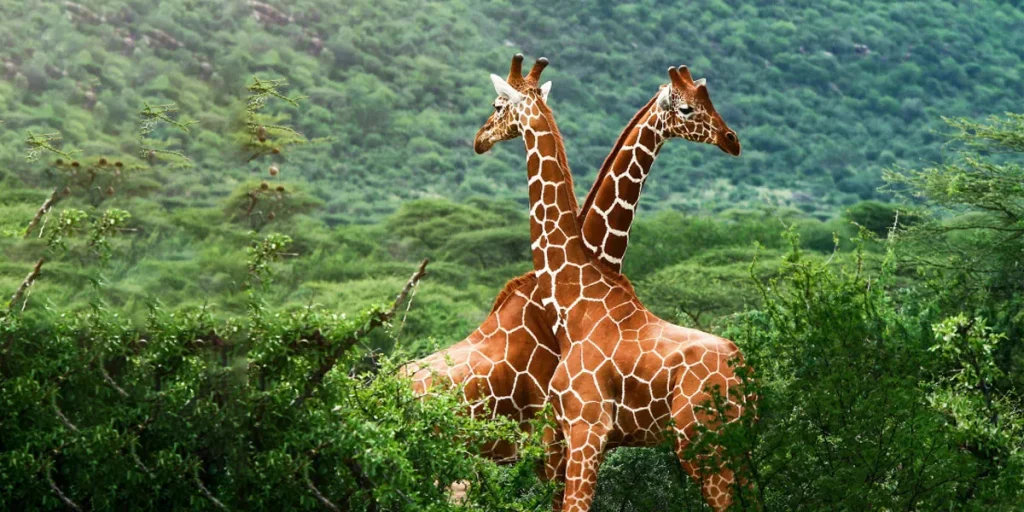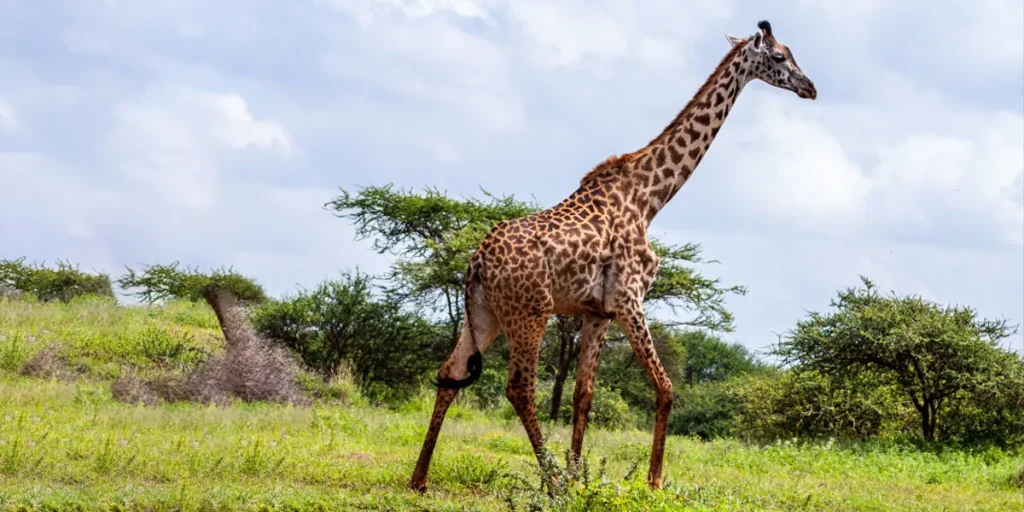A giraffe can weigh anywhere from 1,800 to 3,000 pounds. Adult males typically are heavier than females.
Understanding the marvels of nature can often start with simple questions, like pondering the weight of the tallest land animal, the giraffe.
These majestic mammals, known for their long necks and spotted coats, exhibit significant weight differences between males and females, reflecting their sexual dimorphism.
A male giraffe’s weight underscores its status as a formidable presence on the savannah, while the slightly lighter female still impresses with her bulk.
This vast weight range is a testament to the giraffe’s large size and herbivorous diet, consisting mainly of leaves from towering trees, which supports their considerable mass.
The giraffe’s weight is intriguing not only for its sheer magnitude but also for what it reveals about the unique evolutionary adaptations of these African giants.

Giraffe: A Towering Marvel
The giraffe commands attention as one of the tallest creatures on Earth. With its graceful neck and unique spots, this animal is a wonder of nature.
But beyond its outward appearance, have you ever wondered about its weight? Let’s explore the majesty of this towering marvel together.
Physical Characteristics Of Giraffes
Giraffes are known for their distinctive long necks and spotted coats. This design is not just for show; it helps them survive.
They have a set of unique features:
- Long, muscular legs
- Average of seven neck vertebrae, each elongated
- Large heart to pump blood up their long neck
- Sturdy bone structure to support their mass
Male giraffes can weigh between 2,400 and 3,000 pounds. Females are lighter, typically weighing between 1,600 and 2,600 pounds.
| Gender | Weight Range |
|---|---|
| Males | 2,400-3,000 lbs |
| Females | 1,600-2,600 lbs |
Average Giraffe Heights
Giraffes stand tall above all land animals. This height gives them a big advantage.
Their average heights are impressive:
| Gender | Height (Feet) |
|---|---|
| Males | 16-18 feet |
| Females | 14-16 feet |
Males are generally taller than females. They use their height to spot predators and reach high leaves for food.
Understanding Giraffe Mass

The majestic giraffe, with its towering neck and spotted coat, is a sight to behold on the African savannah.
Yet, one of its most impressive features is often just a number to many: its mass.
Weighty Matters: Understanding Giraffe Mass takes a closer look at the heft of these gentle giants. What tips the scales for these creatures?
The Growth Of Giraffes
Giraffes start their journey as calves weighing around 100 pounds (45 kilograms) at birth. Imagine a newborn that’s already as heavy as an adult human!
These calves grow quickly, gaining weight at an astonishing rate. By the time they reach adulthood, they’ve undergone a drastic transformation.
Adult giraffes can weigh anywhere from 1,800 to 3,000 pounds (815 to 1,360 kilograms).
This weight is due to a combination of their skeletal structure, long necks, and muscle mass required to maintain their towering stature.
| Age Group | Average Weight Range |
|---|---|
| Birth | 100 lbs (45 kg) |
| Weaning (4-6 months) | 600 lbs (272 kg) |
| Adult | 1,800 – 3,000 lbs (815 – 1,360 kg) |
Gender Disparities In Giraffe Weight
In the giraffe world, gender plays a significant role in weight. Male giraffes, also known as bulls, are typically heavier and taller than their female counterparts.
Bulls often tip the scales at the higher end of the adult weight range.
- Males: 2,600 – 3,000 pounds (1,179 – 1,360 kilograms)
- Females: 1,800 – 2,200 pounds (815 – 998 kilograms)
These differences aren’t just for show. A male’s extra mass is advantageous in necking battles, where they fight for dominance and the right to mate.
The heavier, stronger giraffe often emerges as the victor in these skirmishes.
So, the next time you marvel at a giraffe, remember the incredible journey its weight signifies, from a small 100-pound calf to potentially a 3,000-pound adult.
These figures not only reflect the giraffe’s size but also its survival in the wild.
Factors Influencing Giraffe Weight

Giraffes are the tallest mammals on Earth. Their weight can tell a lot about their lifestyle. Two main factors affect how heavy they can get.
The first is what they eat. The second is where they live. Let’s explore how these aspects play into the weight of a giraffe.
The Giraffe Menu: A Vegetation-based Diet
A giraffe’s diet consists mainly of plants. These gentle giants eat leaves from tall trees. They prefer the acacia tree which is rich in nutrients.
Having a good diet keeps giraffes healthy. It also makes them grow big and strong.
- Acacia Leaves: High in protein and minerals.
- Twigs and Branches: Provides fiber.
- Fruits: For vitamins and extra energy.
- Water: Giraffes can go long periods without water.
How Habitat Affects Weight?
The place where giraffes live is called their habitat. It has a big effect on their size. Giraffes that live in places with lots of food grow more.
Those in areas with less food might not weigh as much.
| Habitat | Food Availability | Average Weight |
|---|---|---|
| Savannah | High | Heavier |
| Woodlands | Medium | Medium weight |
| Deserts | Low | Lighter |
Giraffes adapt to their home. If food is hard to find, they might roam far. They make the best of what they have.
Some giraffes even learn to eat new types of plants. This shows how amazing these animals are.
Fascinating Anatomy Of A Giraffe
Giraffes are truly amazing creatures, not only for their impressive height but also for their unique anatomy.
These gentle giants are the tallest mammals on Earth. Their anatomy plays a significant role in their size and weight.
Giraffe Muscle And Bone Structure
A giraffe’s muscle and bone structure is nothing short of remarkable. It provides the strength needed to support its long neck and legs.
The bones are both sturdy and lightweight, giving giraffes their impressive stature.
| Body Part | Muscle and Bone Features |
|---|---|
| Neck | 7 long vertebrae, similar to humans but much larger |
| Legs | Strong bones for support, muscles for movement |
- Giraffe bones are super strong.
- Muscles help them run fast.
Role Of The Giraffe’s Neck And Legs In Its Weight
The neck of a giraffe has a key role in its overall weight. Despite its length, the neck is surprisingly light because of its structure.
Giraffes have heavy bones in their legs to keep them standing tall.
- Giraffe necks are lighter than they look.
- Leg bones have to be strong to hold up a giraffe.
A giraffe’s legs work like supporting pillars. Without strong legs, a giraffe could not stand so tall. Together, their neck and legs make up a big part of their body weight.
The Science Of Giraffe Weight
Have you ever wondered just how heavy a giraffe is? Giraffe weight is crucial for scientists to understand these majestic creatures.
It helps in tracking their health and conserving their populations. In this deep dive, we explore the weight of giraffes through scientific research and conservation efforts.
Studying Giraffe Populations In The Wild
Tracking the weight of giraffes in their natural habitats poses unique challenges. Researchers use innovative techniques to estimate these measures.
Dedicated teams observe giraffe behavior and feed intake. They also use photographic analysis to gauge body condition from a safe distance.
Scientists often employ non-invasive methods to estimate weight. They use height and girth measurements and apply these to regression formulas.
This approach minimizes stress on the giraffes and leaves them undisturbed.
Population growth, migration patterns, and genetic health are other key study areas. These insights guide conservation strategies.
Knowledge of their weight range links to overall habitat health.
Conservation Efforts And The Impact On Giraffe Health
The health of giraffes is a direct reflection of their environment. Conservationists work tirelessly to preserve and restore the giraffes’ natural habitats. This effort helps maintain optimal body weight in these animals.
Initiatives include:
- Anti-poaching patrols to protect giraffes from harm.
- Creating and managing protected areas for safe grazing.
- Community engagement programs to foster co-existence.
- Partnerships with local governments for sustainable land use.
Veterinary interventions are sometimes necessary. These include treatment of diseases and injuries.
These interventions help giraffes regain optimal weights and health. This is crucial for their survival and reproduction.
The path to understanding giraffe weight is full of discovery. It bridges the gap between scientific curiosity and the pressing need for conservation.
Things like dietary studies, genetic analysis, and population dynamics research all play a role.
Weighing these gentle giants is more than numbers. It’s a vital part of safeguarding their future.
As we uncover the science behind giraffe weight, we take important steps towards their preservation.
Weighing The World’s Tallest Animal
Imagine the challenge of weighing a six-meter-tall giraffe. The quest to determine the weight of the world’s tallest land animal has led to some remarkable strategies.
From conservation efforts to health assessments, knowing the weight of these majestic creatures is more critical than it appears.
Innovative Techniques For Measuring Giraffe Weight
- Remote monitoring scales: Park rangers use pressure-sensitive platforms placed at watering holes.
- Sedation and cranes: In certain cases, veterinarians sedate giraffes and lift them onto scales with cranes.
- Weight estimation formulas: Scientists develop equations based on measurements like chest girth to estimate weight without scales.
Record Holders: The Heaviest Giraffes On Record
| Giraffe Name | Weight | Location |
|---|---|---|
| Zeus | 4,250 lbs | Nairobi National Park |
| Apollo | 4,100 lbs | San Diego Zoo Safari Park |
| Savannah | 3,900 lbs | Walt Disney World Resort |
While most giraffes weigh between 1,800 and 2,500 pounds, these record holders have tipped the scales, showcasing just how heavy these animals can be.
Each reflects years of healthy diets and expert care in their respective homes.
FAQs About the Weight of a Giraffe
What Is The Average Weight Of A Giraffe?
Giraffes are large mammals, with adults typically weighing between 1,600 and 2,800 pounds. The females are generally lighter than males.
How Does A Giraffe’s Weight Compare To Other Animals?
Compared to other animals, giraffes are quite heavy. They are heavier than a car but lighter than an African elephant, the latter often exceeding 10,000 pounds.
Can A Giraffe’s Weight Vary By Subspecies?
Yes, a giraffe’s weight can differ depending on the subspecies. For instance, the Masai giraffe weighs more on average than the reticulated giraffe.
At What Age Is A Giraffe Fully Grown?
Giraffes reach full growth by the age of 3 to 5 years. Once fully grown, they maintain a stable weight throughout their adulthood.
Conclusion
Wrapping up our safari of facts, giraffes are truly heavyweight champions of the animal kingdom.
Weighing up to 2,800 pounds, these gentle giants tower over the savannah. Their remarkable mass is a testament to nature’s grandeur, leaving us in awe of Earth’s diverse wildlife.
Remember, their size is a symbol of survival, a balance of grace and strength. Keep exploring the wonders of our planet’s creatures!
Resources:
https://www.henryvilaszoo.gov/animal/reticulated-giraffe/
https://capemaycountynj.gov/1105/Giraffe
